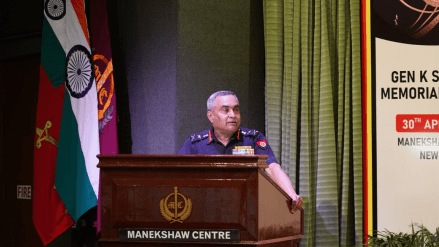The Indian Army is committed to progressive transformation, ensuring modernisation, agility, adaptability, and self-reliance in the face of evolving security challenges, says General Manoj Pande, Chief of the Army Staff (COAS).
In his keynote address at the 4th General Sundarji Memorial Lecture at the Manekshaw Centre, the army chief reflected on General Sundarji’s visionary contributions to military thought. Known as the ‘Father of the Mechanised Infantry Regiment,’ General Sundarji’s foresight encompassed digitization of the battlefield, information warfare, technological advancements, and innovative force structures, as encapsulated in his seminal work, ‘Vision 2100.’ The army chief also paid tribute to the enduring legacy of General K Sundarji — one of India’s preeminent military strategists.
“When we talk about digitisation of the battlefield, we are witness to a manifold increase in the lethality and accuracy of kinetic instruments and increased proliferation of technologies such as – Artificial Intelligence, Quantum Computing, Robotics, 3D printing and Nano-technology. Disruptive and dual use technologies and their proliferation at unprecedented scale – are transforming the character of modern wars,” said the Army Chief.
Adding, “A suite of digital technologies – encompassing Electronic Warfare, Micro-electronics, Drones, precision attack systems, loiter munitions and star link terminals – are challenging traditional force multipliers. Swarming is contesting surging, surveillance and precision are scoring over fire and manoeuvre, and the light and small are prevailing over the large and heavy.”
According to Gen Pande, “Warfare has transcended into new domains, such as Space, Cyber, Electromagnetic Spectrum and Information. Consequent to these developments, conventional force ratios, which were the measure of military strength and superiority in the past, stand blunted today.”
“In the Information Warfare domain, Gen Sundarji opined that information technology would help achieve a competitive edge over the adversary. Today, the growing centrality of Cyber domain in critical national infrastructure and systems, has resulted in it emerging as a new battleground of Digital Confrontation. Information Operations today, have gained new dimensions,” he said.
Gen Sundarji also asserted that ‘New Non-Nation State Actors’ would play a significant role in conflicts of the future.
Today, “we are witness to manifestations of his forecasts. Disruptive and dual use technologies are no longer Super Power centric. These are commercially available and Non-State Actors are gaining access to them, and employing them for military use towards gaining an asymmetric leverage in conflict,” said Gen Pande.
Organised by the Mechanised Infantry Centre & School (MIC&S) and the Centre for Land Warfare Studies (CLAWS), the event drew serving and retired officers from all three Services, alongside esteemed members of the literati and various think tanks.
The lecture also featured speakers, including NN Vohra, former Governor of Jammu and Kashmir, who shared personal anecdotes about General Sundarji and advocated for a robust National Security Policy. Lieutenant General Subrata Saha (Retd), former Deputy Chief of Army Staff and Member of the National Security Advisory Board (NSAB), provided insights into modernising India’s armed forces, drawing valuable lessons from General Sundarji’s illustrious career.
The event underscored the enduring relevance of General Sundarji’s strategic wisdom in navigating contemporary security paradigms.
Beyond his military tributes, General Sundarji’s enduring legacy lies in his thoughtful insights into the evolving nature of warfare and the imperative of adapting to emerging challenges.
According to the official statement issued by the Ministry of Defence on Tuesday (April 30, 2024), in commemorating General Sundarji’s legacy, the Indian Army reaffirms its commitment to modernisation, innovation, and strategic foresight, ensuring the nation’s armed forces remain at the forefront of global security challenges.
